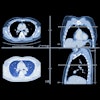Dear AuntMinnie Member,
You can't ignore it any longer -- the RSNA 2011 meeting starts in just a few short weeks.
And what better way to prepare for radiology's showcase conference than Road to RSNA, AuntMinnie.com's comprehensive preview of scientific and educational sessions to be featured November 27 through December 2 at McCormick Place in Chicago.
Our editors have combed through the RSNA's online meeting planner to find presentations that represent the most cutting-edge research in medical imaging. We've organized everything into convenient modality-based sections to make it easier to find exactly what you want as you plan your daily schedule.
Road to RSNA previews on PACS and molecular imaging are already live -- we'll be launching other sections in the days to come. To check it out, go to rsna.auntminnie.com.
CT scans a very large (and very dead) patient
In other news, in our CT Digital Community this week we're featuring a story by staff editor Heather Hokenson on a collaboration between U.S. and Danish researchers that used CT to discover new evidence about the origins of humans in North America.
The group scanned the remains of a mastodon that were discovered in Washington state in 1977. What killed the beast had long been a bone of contention, but CT images combined with radiocarbon dating and DNA analysis were able to pinpoint a date almost 1,000 years earlier than previous estimates for the first humans -- and hunters of the mammoth-sized mammals -- in North America.
View fascinating images -- as well as videos -- collected by the researchers by clicking here, or check out the story in our CT Digital Community, which you can reach at ct.auntminnie.com.




















